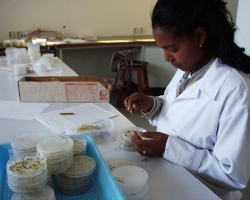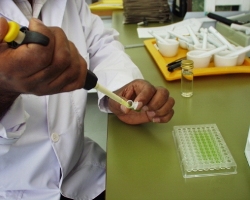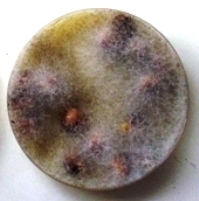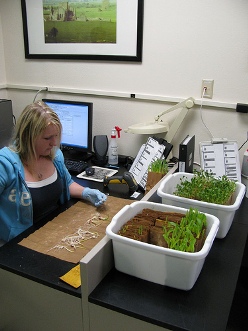Quality testing
|
What is quality testing? |
The quality of seed can be tested with a germination test
|
Monitoring of plant genetic resources germplasm
.jpg) View the full chapter on monitoring by clicking on the icon above. (0.1 MB) |
Page compiled by: Bioversity International/ILRI, Addis Ababa, Ethiopia (Alexandra Jorge); ILRI, Addis Ababa, Ethiopia (Jean Hanson) including information extracted from: Rao NK, Hanson J, Dulloo ME, Ghosh K, Nowel D and Larinde M. 2006. Manual of seed handling in genebanks. Handbooks for Genebanks No. 8. Bioversity International, Rome, Italy. 147pp.
What is germplasm monitoring
Germplasm monitoring is the regular checking of the quality (the viability) and the quantity (the existing stocks in number or weight) of seeds or plant materials of germplasm accessions stored in a genebank.
|
The quality of seed can be tested with a germination test |
Why should accessions be monitored
To avoid excessive deterioration of seed (or plant material) quality or quantity, genebank accessions should be monitored both for viability and seed (or plant material) quantity during storage. There are two main reasons to monitor the accessions:
- The viability of seeds (or the plant material) stored in a genebank decreases during storage. It is therefore important to monitor their viability to ensure that they do not lose their capacity to produce viable plants when needed.
- The removal of seeds or plant material for distribution and germination testing, results in a decrease of seeds or plant material over time. It is important to know how much material is in stock to avoid using all material before regeneration is completed.
- Germplasm accessions identified with low viability or inadequate quantity during the course of monitoring should be regenerated as soon as possible using the methods described in the general or crop sections on regeneration.
Monitoring intervals
The monitoring interval for quality depends on the species, storage environment (seed moisture content and temperature), risk in the field genebank for plants in the field and seed viability or number of plants at the start of the storage period. For seed genebanks the FAO Genebank Standards (2013) recommend that:
- The initial seed viability test should be conducted after cleaning and drying the accession or at the latest within 12 months after receipt of the sample at the genebank.The initial seed viability test is conducted after cleaning and drying the accession or at the latest within 12 months after receipt of the sample at the genebank.The initial seed viability test is conducted after cleaning and drying the accession or at the latest within 12 months after receipt of the sample at the genebank.
- The initial germination value should exceed 85 percent for most seeds of cultivated crop species. For some specific accessions and wild and forest species which do not normally reach high levels of germination, a lower percentage could be accepted.
- Viability monitoring test intervals should be set at one-third of the time predicted for viability to fall to 85 percent or lower depending on the species or specific accessions] of initial viability but no longer than 40 years. If this deterioration period cannot be estimated and accessions are being held in long-term storage at -18C in hermetically closed containers, the interval should be ten years for species expected to be long lived and five years or less for species expected to be short-lived.
- The viability threshold for regeneration or other management decision such as recollection should be 85 percent or lower depending on the species or specific accessions of initial viability.
For field genebanks, monitoring for quality should also cover infection by pests and diseases, adaptation to the site and encroachment of other accessions between plots, as well as viability of the material. It is suggested that monitoring should be weekly to observe any problems as they arise and take action to reduce risks. Additional monitoring should be done daily after new planting, pruning or cutting back and after events that could increase the risk such as heavy rain.
Monitoring for quantity of seeds or propagules is best done on a continuous basis and always before material is distributed in response to requests.
Viability monitoring in seed genebanks
Viability is monitored by conducting a germination test on a fixed sample or by sequential germination.
Fixed sample size germination test
For the fixed sample size germination test, it is recommended to use a minimum of 200 seeds (as two replicates of 100 seeds or four replicates of 50 seeds) if sufficient seeds are available. If the quantity is limited, 50-100 seeds can be tested in two replications. For information on seed germination methods see the section on viability testing.
Sequential germination tests
The sequential germination test uses fewer seeds per replicate than the standard germination test. As the name suggests, the germination test is done sequentially on replicates and stopped as soon as the results allow a decision to be made on whether regeneration is necessary. Otherwise, the methods and conditions for germination are the same as described for the fixed sample size germination test (see the section on viability testing).
The number of seeds required for each replicate may vary, but it is recommended to use at least 40 seeds per replicate. The first replicate of seeds is tested and the number of seeds that germinate are counted. If the number of seeds germinated is 29 or less, the accession requires regeneration. If more seeds germinate the test is repeated with another replicate of 40 seeds and the results of the two tests added. If less than 64 seeds germinate, the accession requires regeneration and if more than 75 seeds germinate regeneration is not necessary. The test can be repeated until a decision on regeneration can be made but no more than ten times.
Documentation
Monitoring is a crucial activity in genebank management as it helps to provide information on seed stocks that are becoming low, accessions that need viability testing and those that require regeneration. Without proper documentation of the data from preceding genebank activities, effective monitoring is difficult to carry out.
References and further reading
Engelmann F, Engels JMM. 2001. Technologies and strategies for ex situ conservation. In: Engels JMM, Ramanatha Rao V, Brown AHD, Jackson MT, editors. Managing plant genetic diversity. CABI, UK. 512p.
Engels JMM, Visser L, editors. 2003. A guide to effective management of germplasm collections. IPGRI Handbooks for Genebanks No. 6. IPGRI, Rome, Italy. Available in English (1.4 MB) and Spanish (1.5 MB).
FAO. 2013. Genebank standards for plant genetic resources for food and agriculture. Food and Agriculture Organization of the United Nations, Rome. Available in English, Spanish, French, Arabic, Russian and Chinese here.
Viability testing of germplasm
.jpg) View section on seed viability testing by clicking on the icon above (0.7 MB) |
Page compiled by: Bioversity International/ILRI, Addis Ababa, Ethiopia (Alexandra Jorge); ILRI, Addis Ababa, Ethiopia (Jean Hanson) including information extracted from: Rao NK, Hanson J, Dulloo ME, Ghosh K, Nowel D and Larinde M. 2006. Manual of seed handling in genebanks. Handbooks for Genebanks No. 8. Bioversity International, Rome, Italy. 147pp.
What is viability testing
Seed or plant viability is the measure of how many seeds or how much plant material in a lot are alive and could develop into plants that will reproduce under appropriate field conditions.
Why should viability be determined
|
Testing seed viability (photo: ILRI) |
It is very important that seeds or plant material stored in the genebank are capable of producing plants when sown in the field. They must have high viability at the start of storage and maintain it during storage. Seeds or plant material with a high initial viability will also survive longer in storage. Seed or plant viability declines slowly at first and then rapidly as the seeds or plant material age. It is important to know when this decline occurs in order to take action to regenerate the accession. Excessive deterioration will lead to loss of material.
When should viability be determined
Seed material
- Before seeds are packaged and placed in the genebank.
- At regular intervals during storage.
Viability testing is crucial for the monitoring of seed conservation. It can take from a few days to weeks, depending on the species. If possible, the results of viability tests should be made available before seeds or plant material are packaged and placed in the genebank so that poor quality seeds can be identified and regenerated.
While awaiting the results of viability tests, or if there is a delay in conducting the viability tests before storage, seeds should be placed in a cool environment to minimize their deterioration.
Tissue culture plant material
- Viability tests should be carried out after long periods of storage.
- When abnormalities are seen.
Cryo plant material
- Short term after induction.
How should viability be determined
The determination of viability depends on the species and method of conservation.
Seed material
- Many different methods are available to test seed viability.
- The most accurate and reliable method is the germination test.
- There are also biochemical tests, which have the advantage of being quicker, but are not as accurate as the germination test. They also require special skills to conduct and interpret. These tests are not usually recommended for general use to test for seed viability in genebanks.
Plant material (tissue culture and cryopreservation)
- The viability test is used to test whether the material can be rejuvenated into a whole plant that can grow under natural conditions.
The germination test (applicable for seeds)
|
Testing germination in sand (photo: ILRI)
Testing germination on filter paper (in tray)(photo: ILRI) |
What is a germination test
A germination test is performed to determine what proportion of seeds in an accession will germinate under favourable conditions and produce seedlings judged as normal according to specific criteria for each species [see Association of Seed Analysts (AOSA), 2005; ISTA, 2005]. This is because the aim of seed testing is to give an indication of how the seeds will perform as propagules in the field.
When are seedling defects classified as abnormal?
How is germination tested
Basic requirements for seed germination are: water, oxygen, light and suitable temperature. Seeds of different species have different requirements and no general set of conditions can be relied upon to germinate seeds of all species. Seeds of some species are more tolerant and germinate in a wide range of conditions but complete germination can only be achieved under optimum conditions. Seed dormancy is seen when seeds imbibe water under suitable temperature and light for germination but germination does not occur.
- Before germination, seeds need to be humidified and often pre-treatments need to be used to break dormancy:
- A variety of methods are recommended for each species:
- But sometimes there are species without much information and new methods need to be developed:
- Backup procedures can also be used to identify viable but dormant seeds that fail to germinate at the end of germination tests:
-
The most common methods are detailed in the links below and illustrated in the flip books.
-
Top of paper germination method: Flipbook, Text (print version).
- Between paper germination method: Flipbook, Text (print version).
- Germination in sand method: Flipbook, Text (print version).
-
Agar germination method: Flipbook, Text (print version).
-
Top of paper germination method: Flipbook, Text (print version).
How many seeds should be tested
- A fixed sample size germination test using 200 seeds in 4 replicates of 50 seeds is recommended as best practice to determine viability at the beginning of storage.
- Four replicates of 100 seeds is recomended in the ISTA rules. However, best practices take into account the limited number of seeds available and the aim of not wasting seeds in unnecessary testing.
- Overall seed viability should be taken as the mean of the replicates.
References and further reading
AOSA (Association of Official Seed Analysts) 2005. Page 113 in: Rules for Testing Seeds (Capashew Ed.), 4-0, 4-11. Las Cruces, NM.
FAO. 2013. Genebank standards for plant genetic resources for food and agriculture. Food and Agriculture Organization of the United Nations, Rome. Available in English, Spanish, French, Arabic, Russian and Chinese here.
ISTA. 2008. International Rules for Seed Testing. International Seed Testing Association. ISTA secretariat, CH-Switzerland. Available from: www.seedtest.org/.
Rao NK, Hanson J, Dulloo ME, Ghosh K, Nowel D, Larinde M. 2006. Manual of seed handling in genebanks. Handbooks for Genebanks No. 8. Bioversity International, Rome, Italy. Available in English (1.5 MB), Spanish (1.4 MB) and French (1.9 MB).
Thormann I, Metz T, Engels JMM. 2004. The Species Compendium (release 1.0; December 2004). [online] Available from: http://www.bioversityinternational.org/databases/species_compendium_database/index.html. Date accessed 09 April 2013.
Health diagnosis
.jpg) View section on seed health testing by clicking on the icon above. (0.7 MB) |
Page compiled by: Bioversity International/ILRI, Addis Ababa, Ethiopia (Alexandra Jorge); ILRI, Addis Ababa, Ethiopia (Jean Hanson) including information extracted from: Rao NK, Hanson J, Dulloo ME, Ghosh K, Nowel D and Larinde M. 2006. Manual of seed handling in genebanks. Handbooks for Genebanks No. 8. Bioversity International, Rome, Italy. 147pp.
The importance of plant health
Seed or plant health refers to the disease status of a seed or plant sample and the presence or absence of disease-causing organisms and pests.
|
Assessing seed health (photo: ILRI) |
|
Looking for infected seed (photo: ICARDA) |
|
Seeds contaminated with fungi (photo: ILRI) |
Why is plant health testing important
Crops are frequently infected with a range of common seed-borne or systemic pathogens that may not be visible or easily recognized during seed collection. Seed-borne or systemic inoculums may reduce longevity during storage and cause poor germination or field establishment. Seed-borne and systemic inoculums also are a source of infection and spread disease in the field, reducing the value of crops. Exchange of infected seeds or plant material may allow spread of diseases and pests into new regions. Genebanks should ensure that seeds or plant material prepared for conservation are free from seed-borne or systemc diseases and pests.
Common seed-borne or systemic pests and pathogens
There are four main types of common organisms that are carried in seeds or plant material and affect a wide range of crops:
- Fungi.
- Bacteria.
- Viruses.
- Insects.
Specific methods for detecting pathogens vary by organism and host, and specific methods are required for accurate identification of most pathogens.
See the safe movement of germplasm section on this site for lists of common pathogens of quarantine importance for a range of crops and information on best practices for safe movement of germplasm.
References and further reading
Albrechtsen SE. 2005. Testing methods for seed-transmitted viruses: Principles and protocols. Oxford University Press, UK.
CABI, Crop Protection Compendium. 2007. CD-ROM Edition. Available from: www.cabicompendium.org/cpc Date accessed: 24 March 2010.
EPPO (European and Mediterranean Plant Protection Organization) standards. The EPPO bulletin is available from: http://www3.interscience.wiley.com/journal/118486049/home Date accessed: 24 March 2010.
Transgene detection
.jpg) View section on seed testing for inadvertent introduction of transgenes by clicking on the icon above. (0.7MB) |
Page compiled by: Bioversity International/ILRI, Addis Ababa, Ethiopia (Alexandra Jorge); ILRI, Addis Ababa, Ethiopia (Jean Hanson) including information extracted from: Rao NK, Hanson J, Dulloo ME, Ghosh K, Nowel D and Larinde M. 2006. Manual of seed handling in genebanks. Handbooks for Genebanks No. 8. Bioversity International, Rome, Italy. 147pp.
(More information on Transgenes can also be found at the genetic identity page under Management strategies).
What are transgenes
Transgenes are genes that are introduced into another organism or species through recombinant DNA techniques. Transgenic plants carry transgenes in their genomes and transmit them to their progeny through normal reproduction.
Why determine the presence of a gene/transgene
One of the most important components of proper genebank management is testing for the presence of a gene or phenotype. This is critical for various phytosanitary requirements, but is also becoming important for the detection of transgenes. There are a number of reasons why it is important to detect the presence of a gene/transgene in a genebank accession. While not an exhaustive list, these include:
- Regulatory issues, especially related to phytosanitary or biosafety, where the country of import, and potentially the country of export, requires reporting on the presence of such genes.
- Situations in which the presence of such a gene/transgene could affect intellectual property rights either in the country where the genebank is located or in a country where the accession is to be sent.
- Social issues requiring genetic identity to be stated or that certain genes/transgenes be limited.
It is generally accepted as unwise for crops containing transgenes to be incorporated into germplasm collections. The risk of inadvertent inclusion of transgenes can be classified as follows:
- High probability: typically out-crossing crops with sexually compatible relatives on which extensive research in the field or commercial release is ongoing.
- Low probability: typically crops which are highly self-pollinating, multiplied vegetatively or crops for which genetic engineering has either not been done or is in its very early stages.
- Medium probability: the remainder of crops.
- Immediate attention: crops with transgenes that are already commercially distributed.
- Near-future attention: experimental field work is ongoing or expected within one to three years.
- Long-term attention: crops for which no significant work has been done in the field.
Genebanks should take proactive steps to limit the risk of exotic genes, including transgenes, in their ex situ collections. Accessions that do not require testing include:
- Species where no transgenic events (commercial or research) have occurred.
- Accessions for which there were no commercial transgenes present at the time of acquisition (such as maize prior to 1996) or no transgenics near the collecting site.
- Accessions for which there have been transgenic events, but good management practices have been followed in the accession process.
Procedures to prevent unintentional gene flow from genetically modified organisms (GMOs)
Transgenes and conventional genes are subject to the biological processes of mutation, gene flow, introgression, recombination and natural selection. Therefore, best practices for preventing introgression of conventional genes also provide an appropriate basis for preventing introgression of transgenes.
Germplasm is most at risk from gene flow during regeneration (see also information on Regeneration) and controlling gene flow is essential to ensure genetic integrity. To reduce the risk in crops where transgenes are commonly part of new cultivars, it is recommended that regeneration be carried out in isolation from any areas where transgenic crops are likely to be grown.
Information on crops’ transgenic status is essential to determine what measures, if any, are needed to confirm that germplasm is free of transgenes. It is recommended that:
- All results be made publicly available as soon as they have been confirmed.
- All procedures and supporting information be presented.
- The appropriate authority in the country of origin be informed in cases where transgenes are detected.
- For commercially released genetically modified crops and crops in experimental development, genebanks maintain a database of crops and their status in transgenic research.
Once an accession has either been determined to not require testing or has tested negative, follow appropriate regeneration and maintenance procedures to maintain genetic integrity, as for all accessions.
Procedures for testing for presence of GMOs
The two basic methods to detect the presence of a gene/transgene are ELISA and PCR amplification. Both methods have already been described and are robust, although each has advantages and disadvantages. For example, ELISA detects the presence of a gene product (protein) and thus requires an expressing gene. Test kits are commercially available for most commercial events, which can be used in the field. On the other hand, PCR can detect non-expressing gene sequences, in almost all tissues, but it is more difficult to perform and therefore not practical in the field. In most cases, the detection of a positive result using one method should be confirmed with a second method. If the material is being analyzed at the molecular level for fingerprinting or diversity studies, an additional test for the presence of a transgene can be performed at minimal cost.
The genes/transgenes that should be used in such tests include the current commercialized major events for the species. These can normally be found on the Internet and are indicated in the tests provided by commercial testing services (either as ELISA kits or PCR services). These will change as new transgenic events are introduced into the market or events become obsolete and are removed, although the need to test may continue for some time. The number of seeds in any accession may limit the level of detection.
Documentation
Suggested descriptors to document accession-level information on the presence of transgenes include the following:
- Source of the material for testing.
- Type of material (leaf, seedling, seed).
- Number of plants sampled and tested per replicate.
- Number of replicates.
- Transgenes tested.
- Method of testing.
- Date of test.
- Duration of test, if appropriate.
- Transgenes identified.
- Incidence of each transgene (%).
References and further reading
Guiding principle of procedures aimed at preventing the unintentional introgression of transgenes into the collection was prepared and adopted by the Genetic Resources Policy Committee (GRPC) and the Science Council of the CGIAR in 2004 (and revised by FAO in 2005). For more information on this subject consult the document available from: http://www.cgiar.org/corecollection/docs/Guiding_Principles_Ex_Situ_Collections_Apr_2007.pdf or the FAO website at: www.fao.org/biotech/news_list.asp?thexpand=1&cat=131. Date accessed: 26 March 2010.
More information and technical guidance on sampling and detection of GMOs is available from: http://eur-lex.europa.eu/LexUriServ/LexUriServ.do?uri=CELEX:32004H0787:EN:HTML. Date accessed: 26 March 2010.
An updated list of validated methods is also available from: http://mbg.jrc.ec.europa.eu/. Accessed 24 March 2010.
CIMMYT. 2005. Laboratory Protocols: CIMMYT Applied Molecular Genetics Laboratory. Third Edition. Mexico, D.F.: CIMMYT.
ISBN: 9686923306. Available from: www.cimmyt.org/english/docs/manual/protocols/abc_amgl.pdf. (1.9MB).
Germplasm testing
.jpg) View the full chapter on seed quality testing by clicking on the icon above. (0.7 MB) |
Page compiled by: Bioversity International/ILRI, Addis Ababa, Ethiopia (Alexandra Jorge); ILRI, Addis Ababa, Ethiopia (Jean Hanson) including information extracted from: Rao NK, Hanson J, Dulloo ME, Ghosh K, Nowel D and Larinde M. 2006. Manual of seed handling in genebanks. Handbooks for Genebanks No. 8. Bioversity International, Rome, Italy. 147pp.
Proper handling procedures in genebanks are fundamental to the long-term, cost-effective and efficient conservation of plant genetic resources of the same genetic identity as the original collection. It is very important that germplasm stored in genebanks is capable of producing plants after storage when sown in the field. Genetic resources samples must have high viability at the start of storage and maintain it during storage and should have the same genetic makeup as at the time of collection to avoid loss of diversity during storage. Accessions are tested and monitored both at the start and during conservation in order to ensure the quality of the material in the genebank.
|
Testing the germination of seeds at the USDA genebank (photo: L. Guarino, by kind permission of USDA genebank in Ames, Iowa, USA) |
What is germplasm testing
The quality testing of seeds or plant material assures that the material to be conserved is in good condition, i.e. it can be grown again (viable) and is free of external contaminants (pests and diseases) and external genes (artificially produced genes). Monitoring of viability during storage allows careful observation the material and ensures that it is not lost through loss of viability or genetic integrity during conservation.
Germplasm is usually tested for
Viability and quantity are also monitored during the storage period.




.JPG)

.jpg)


.jpg)



